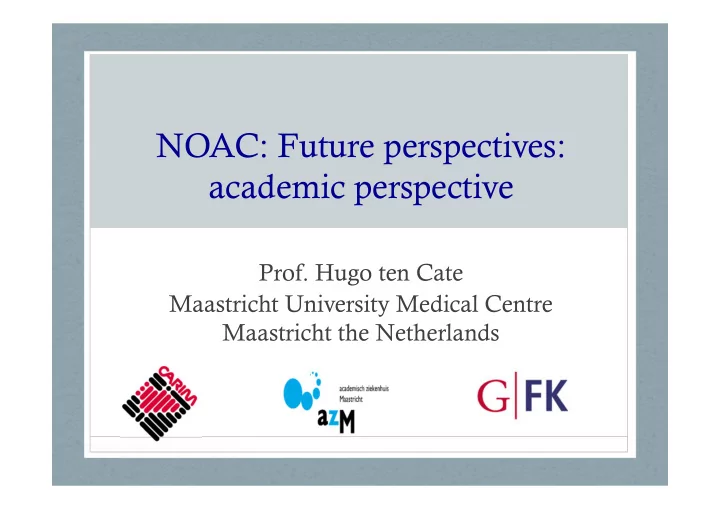

NOAC: Future perspectives: academic perspective Prof. Hugo ten Cate Maastricht University Medical Centre Maastricht the Netherlands
To discuss • Lessons from the NOAC-VKA studies and optimal VKA management • How to improve the quality of NOAC?
(A) stroke or systemic embolism B) major bleeding * * * * * Cameron C et al. BMJ Open 2014;4:e004301
Mean TTR in NOAC studies ≥ 70 Wallentin et al. Lancet 2010, vol 376:975-83 Wallentin et al, Lancet 2010
Quality VKA • TTR of ≥ 70% is recommended in the European Society of Cardiology guidelines 1 • Mean TTR ranged from 55–65% in the warfarin arm of key trials of non-VKA oral anticoagulants 2-4 1. Camm AJ et al. Eur Heart J. 2012. 2.Patel MR et al. N Engl J Med. 2011. 3. Connolly SJ et al. N Engl J Med. 2009 4. Granger CB et al. N Engl J Med. 2011.
TTR and effectiveness Wallentin et al. Lancet 2010, vol 376:975-83 Wallentin et al, Lancet 2010
TTR and Bleeding cTTR <57.1 cTTR> 72.6 Wallentin et al. Lancet 2010, vol 376:975-83
Intracranial hemorrhage (n=68.797) Risk ICH red: per treatment year, blue: age groups Sjogren, TH 2015
Lessons from VKA TTR > 70% offers greater protection against TE stroke (and • mortality) than poorly controlled VKA At TTR > 70% bleeding complications are acceptable (in • Sweden) In NOAC trials the average comparator (warfarin) had a rather • modest TTR (55-64%) So, why are we satisfied with non-inferior or limited superiority • of NOAC as compared to suboptimal warfarin. • Implication is that NOAC therapy should be improved!
To tackle with NOAC • Fixed dose; why not assess individual’s response and suitability for specific NOAC? • Improve adherence • How to monitor, reversal, thrombolysis, after recent stroke; when to resume; after ICH, in multi-morbid geriatric patients, during episodes of intercurrent disease.. ten Cate H. Thromb J. 2013 Jun 28;11(1):8. ten Cate H. Thromb Haemost. 2012 May;107(5):803-5. Hankey. Thromb Haemost 2014; 111: 808
Does one size fit all?
Dabigatran trough & outcomes Reilly et al , J Am Coll Cardiol, 63 (4) 2014: 321 - 328 .
Levels & Patient characteristics • Long-term FU RE-LY, 9183 pt, 112 isch. stroke (1.3%), 323 major bleed (3.8%) • IS inversely related to trough (p=0.045),age and previous stroke (p<0.0001) • Major bleed related to dabigatran overexposure (p<0.0001),age (p<0.0001) , ASA use (p<0.003) and diabetes (p<0.018) Reilly et al. J Am Cardiol 2014;63:321-8
Variability Dabigatran levels Chan et al, Thromb Haemostas 2015: 13( 3), 353-359
Edoxaban trough & outcomes Ruff et al, Lancet 2015
Rivaroxaban Levels_Riva20mg Median peak (IQR) 600 Levels_Rivaroxaban ng/ml 400 200 0 h s s s t h h h n t t t o n n n m o o o m m m 1 < 3 6 2 1 N=44 Ten Cate-Hoek et al, unpublished
Levels per patient over time Rivaroxaban 20 mg Levels_Rivaroxaban N=44 600 Levels_Rivaroxaban ng/ml 400 200 0 h h s s s h h h t t n n t t t o o n n n m m o o o m m m 1 1 < 3 6 2 1
Conclusion from PK analyses • Data suggest that at least for dabigatran we should check dose-responses in individuals • Data are sufficiently robust to merit assessing individual trough levels • Instead of concentrations, quantitative assays may be used • This cannot lead to individual dose optimization for a single NOAC beyond registered doses
How to proceed? • Informed decision on type of anticoagulant (VKA or NOAC) • Assess optimal drug (and dose) response to determine whether drug X is appropriate using a quantitative assay (and/or concentration assay?). • If trough is in extreme end (lower 10 or 20%): either tailoring to other dose or switch drug (other NOAC or VKA). • If it is within range it provides a personal patient’s bench mark for unanticipated situations
New studies: what is the basis? • We need all available data on dose response relationships from the large trials on all NOAC, including for concentrations and activity assays (PT, TG etc); therapeutic ranges! • Analysis of such data could provide sufficient information to decide on the necessity of PK based NOAC selection • In practice: “PK” options may be limited: settle for trough or peak (eg in odd dosed NOAC)
New studies 2? For each patient benchmark data on “PK” are useful • In case of registries such information could be linked to • outcomes to obtain additional and “real life” data Specific problems require study of NOAC • concentration/activity levels: intercurrent illness requiring hospitalization/antibiotic treatment/ dehydration/ bleeding and trhomboembolic complications etc. Why? To make better informed decisions on drug • management!
Structured FU Structured follow-up of patients on NOACs. It is mandatory to ensure safe and effective drug intake. Heidbuchel H et al. Europace 2013;15:625-651
Conclusions • NOAC (and VKA) treatment should be improved • Optimize drug and dose selection based on individual criteria (also including PK) • Optimize long term follow up • Investigate consequences of intercurrent illness on anticoagulant management (TE, bleeding, infectious diseases, congestive heart failure etc)
Recommend
More recommend